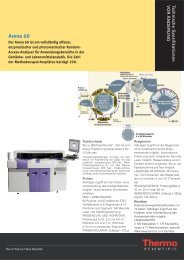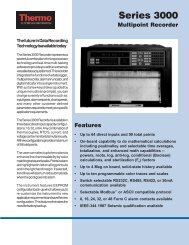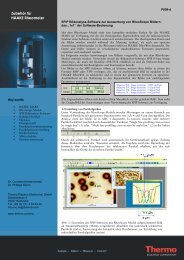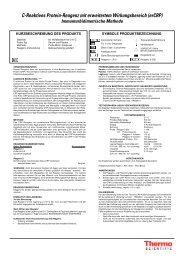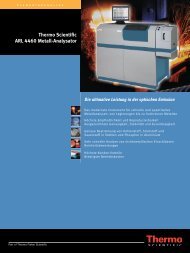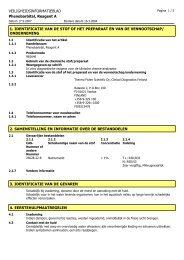Basic UV-Vis Theory, Concepts and Applications
Basic UV-Vis Theory, Concepts and Applications
Basic UV-Vis Theory, Concepts and Applications
Create successful ePaper yourself
Turn your PDF publications into a flip-book with our unique Google optimized e-Paper software.
<strong>Basic</strong> <strong>UV</strong>-<strong>Vis</strong> <strong>Theory</strong>, <strong>Concepts</strong> <strong>and</strong> <strong>Applications</strong><br />
The radiation from normal hot solids is made up of many wavelengths <strong>and</strong> the energy emitted at any particular wavelength<br />
depends largely on the temperature of the solid <strong>and</strong> is predictable from probability theory. The curves in Figure 3 show the<br />
energy distribution for a tungsten filament at three different temperatures. Such radiation is known as 'black body radiation'. Note<br />
how the emitted energy increases with temperature <strong>and</strong> how the wavelength of maximum energy shifts to shorter wavelengths.<br />
More recently it has become common practice to use a variant of this - the tungsten-halogen lamp. The quartz envelope<br />
transmits radiation well into the <strong>UV</strong> region. For the <strong>UV</strong> region itself the most common source is the deuterium lamp <strong>and</strong> a <strong>UV</strong>-<br />
<strong>Vis</strong>ible spectrometer will usually have both lamp types to cover the entire wavelength range.<br />
Quantum <strong>Theory</strong><br />
Figure 3 Tungsten filament radiation<br />
To gain an underst<strong>and</strong>ing of the origins of practical absorption spectrometry, a short diversion into quantum theory is necessary.<br />
For this purpose, it is best to think of radiation as a stream of particles known as photons instead of the waves considered<br />
earlier. Atoms <strong>and</strong> molecules exist in a number of defined energy states or levels <strong>and</strong> a change of level requires the absorption<br />
or emission of an integral number of a unit of energy called a quantum, or in our context, a photon.<br />
The energy of a photon absorbed or emitted during a transition from one molecular energy level to another is given by the<br />
equation<br />
e=hν<br />
where h is known as Planck's constant <strong>and</strong> ν is the frequency of the photon. We have already seen that c= νλ ,<br />
therefore, E= hc/λ<br />
Page 3 of 28



